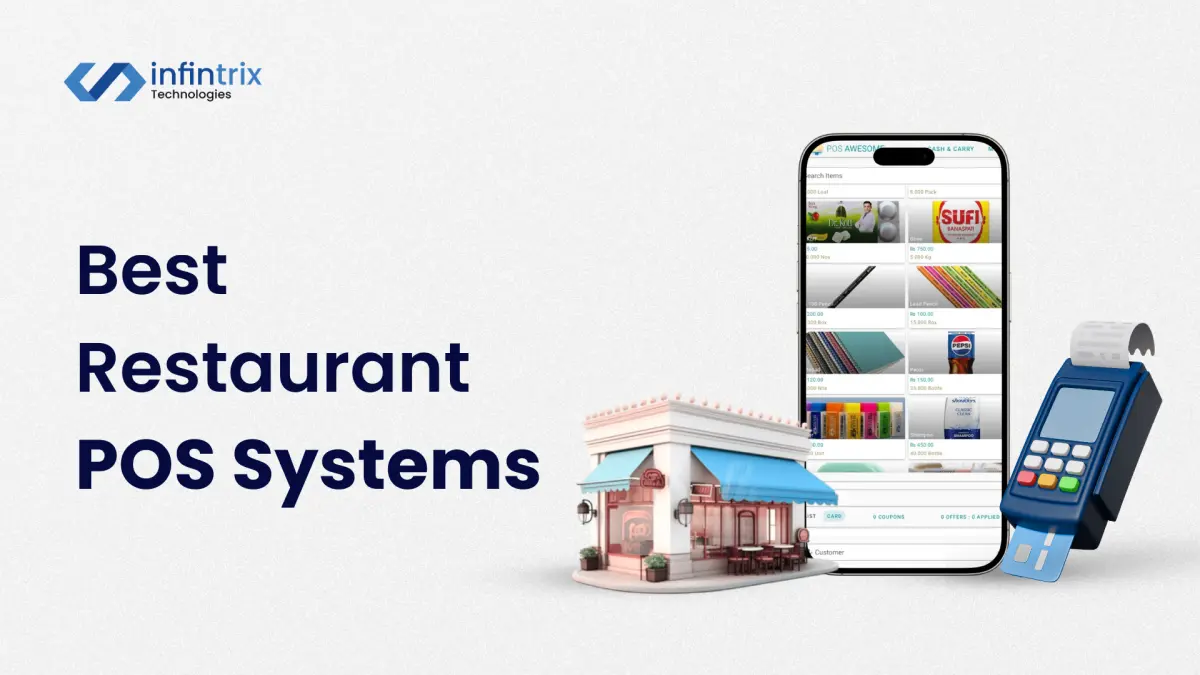Running a restaurant today isn’t just about great food and service—it’s about having the right tech behind the scenes. A restaurant POS system does far more than process payments. It manages orders, tracks inventory, integrates with delivery apps, and keeps your team moving fast.
This guide will walk you through the best restaurant POS systems 2025 picks, compare features side by side, and help you decide which one fits your style of business. Whether you own a small café, a multi-location chain, or a food truck, you’ll find clear answers here.
Quick Picks: Top POS Systems by Restaurant Type
If you’re in a rush, here are the top POS for restaurants based on size and type. We’ve broken it down so you don’t have to sort through every option. Each pick balances cost, ease of use, POS system features, and support.
These recommendations consider mobile POS system flexibility, payment processing integration, and whether you need scalability for multiple locations. Quick picks are a smart way to skip the noise and get straight to what works.
Best Overall POS for Restaurants
Square POS is the all-rounder. Its restaurant POS features include online ordering, loyalty tools, and smooth card payments. Perfect for businesses that want a simple setup with plenty of add-ons.
Best POS for Small Restaurants & Cafes
If you run a cozy spot, the best POS for a small restaurant needs to be affordable and simple. Clover Flex shines here—it’s compact, supports POS software for cafes, and doesn’t drown you in extras.
Best POS for Multi-location Chains
Toast’s multi-location POS system is designed for consistency. Centralized reporting and menu updates mean you can run five or fifty locations without losing control.
Best POS for Food Trucks & Pop-ups
Food trucks need a mobile POS system with an offline mode. SumUp is lightweight, affordable, and doesn’t choke on weak Wi-Fi—ideal for street vendors.
Best Low-cost / Budget Option
SpotOn gives you a starter-friendly restaurant POS system with basic features at a fraction of the cost. Great if you’re testing a new concept without committing big upfront.
Best Open-Source POS Option
POS Awesome is a modern open-source restaurant POS system built on ERPNext. It’s perfect for owners who want full control without monthly subscription fees. With features like offline mode POS, loyalty programs, and inventory management POS, it’s a strong alternative to paid platforms.
Restaurant POS Comparison Table
With so many vendors, it’s tough to compare on paper. This POS pricing comparison table breaks down what you actually need to see: costs, restaurant POS features, and hardware compatibility.
Think of it as a cheat sheet. Instead of clicking 10 websites, you’ll have the POS subscription model details, restaurant POS cost, and payment processing integration differences all in one glance.
Feature & Pricing Highlights
Here’s a quick side-by-side look:
| POS System | Starting Price | Key Features | Best For | Hidden POS Fees |
| Square POS | $0 + transaction fees | Online ordering, POS, CRM tools, and inventory management POS | Versatility | Payment processing rates |
| Toast POS | $69/mo | Menu management software, KDS, loyalty | Full-service restaurants | Hardware leasing costs |
| Clover POS | $14.95/mo | Table management, POS, and delivery integrations | Small & mid-size | Payment gateway fees |
| POS Awesome | Free (open-source) | Batch pricing, offline mode POS, loyalty, sales by weight | Open-source ERPNext users, budget-conscious owners | Requires tech support for setup/updates |
| Lightspeed | $69/mo | Advanced inventory management POS | Growth-focused restaurants | Add-on integrations |
| SumUp/SpotOn | $0–$29/mo | Mobile POS system, offline mode | Food trucks/budget buyers | Card transaction fees |
Hardware Compatibility Snapshot
- Square POS: iPad, Android tablets
- Toast POS: Proprietary hardware only
- Clover POS: Branded hardware + select tablets
- Lightspeed: iPad-focused
- SumUp/SpotOn: Works with mobile card readers
- POS Awosome: Best for Open-Source Flexibility
In-Depth Reviews of the Best POS Systems
Now let’s dig deeper. Each restaurant POS system shines in its own lane, so the trick is matching features with your needs. Pay attention to extras like CRM and loyalty tools, inventory management, POS, and whether the system supports online ordering POS.
We’ll also cover real-world downsides—like hidden costs or lack of flexibility—so you can avoid surprises. Think of this as your trusted “friend review,” not just another sales pitch.
1. Square POS — Best for Versatility
Square keeps things easy. With no monthly fee and a slick app, it’s the go-to for startups. The restaurant POS features include digital receipts, online ordering, and basic loyalty programs. Downsides? Processing rates can add up if your ticket sizes are high.
2. Toast POS — Best for Full-Service Restaurants
Toast shines with menu management software, a built-in kitchen display system (KDS), and strong reporting. It’s perfect for sit-down restaurants. The catch? You’ll need their proprietary hardware, and the restaurant POS cost can climb quickly with add-ons.
3. Clover POS — Best for Flexibility & Add-ons
Clover POS stands out for customization. Its table management, POS, and wide app marketplace let you add features as you grow. It’s great for cafés and mid-size eateries, but be cautious of hidden POS fees from third-party processors.
4. POS Awesome — Best for Open-Source Flexibility
POS Awesome is a community-driven cloud-based restaurant POS built on ERPNext. It upgrades the default POS with a cleaner interface, faster checkout, and advanced tools like batch-based pricing, sales by weight, and strong offline mode POS support. Restaurants that want open-source control love its flexibility.
5. Lightspeed POS — Best for Inventory Management
If tracking stock is your pain point, Lightspeed is the champ. Its inventory management POS goes deep—think low-stock alerts, vendor ordering, and recipe costing. That said, it leans on iPad hardware and the restaurant POS cost isn’t cheap once you add integrations.
6. SumUp / SpotOn — Best for Small or Budget Buyers
For tight budgets, both SumUp and SpotOn hit the sweet spot. They offer mobile POS system setups with offline mode, which is huge if Wi-Fi fails. The tradeoff? Limited advanced tools compared to bigger players, but they’re unbeatable for entry-level pricing.
How to Choose the Right POS for Your Restaurant
Picking the right restaurant POS system isn’t about chasing the flashiest features. It’s about matching the system to your restaurant’s size, service style, and growth plans. A small café doesn’t need enterprise-level tools, but a chain can’t survive on entry-level software.
Think of this section as a checklist. By walking through each step, you’ll know exactly which POS is right for you—and avoid overpaying for things you’ll never use.
Step 1: Assess Your Restaurant Type & Scale
The best POS for a small restaurant focuses on simplicity, while a multi-location POS system needs advanced syncing. Quick tip: Write down your restaurant’s must-haves before even looking at demos.
Step 2: Must-have Features vs. Nice-to-have Extras
Some restaurant POS features are non-negotiable—like inventory tracking and payment processing integration. Others, like advanced loyalty programs, may be “nice-to-have.” Prioritize essentials first to keep your budget in check.
Step 3: Integration Checklist (Delivery Apps, Payments, Accounting)
The right system should connect with online ordering POS, delivery apps, and accounting tools. Without solid integrations, you’ll waste hours reconciling sales data.
Step 4: Security, PCI Compliance & Data Ownership
Restaurants handle sensitive payment data daily. Look for cloud-based restaurant POS systems that are PCI compliant and give you ownership of customer information. This avoids headaches if you ever switch providers.
Step 5: Hardware Decisions (Cloud vs On-Premise)
You’ll need to decide: do you want an on-premise POS system (local servers, more control) or cloud-based (scalable, accessible anywhere)? For most, cloud wins thanks to lower upfront costs and flexibility.
Tip: Many restaurants struggle with integrations like online ordering apps, accounting tools, or loyalty programs. That’s exactly where our team of Infintrix Technologies helps — we specialize in connecting POS systems with your ERP escpecially (ERPNext), so everything runs smoothly behind the scenes.
Implementation & Migration Playbook
Switching POS systems can feel daunting, but it doesn’t have to be. With a clear plan, you can migrate smoothly while avoiding downtime and frustrated staff. This section gives you the playbook most vendors don’t share upfront.
Think of it like moving to a new house: pack carefully, test everything, and train your team before inviting guests in.
Pre-migration Steps (Data Export, Menu Mapping)
Before flipping the switch, export old sales data, customer info, and menus. Clean up duplicates, then map menus into the new menu management software so everything is accurate from day one.
Pilot & Staff Training Plan
Run a pilot at one terminal or location before a full rollout. Offer staff hands-on training & onboarding POS sessions so they feel confident. A well-trained team = fewer service hiccups.
Common Pitfalls & Troubleshooting Tips
Biggest pitfalls? Forgetting to test offline mode POS, skipping staff training, or underestimating setup time. Always have backup payment options in case something goes sideways.
Implementation Timelines & Resource Checklist
A realistic rollout usually takes 2–6 weeks, depending on size. Create a resource checklist: hardware, staff hours, vendor support contacts, and a go-live date. Planning avoids last-minute stress.
FAQs & Expert Verdict:
To finish, let’s tackle the burning questions most restaurant owners ask before buying.
How Long Does It Take to See ROI?
Most restaurants see ROI from their POS system within 3–6 months through saved labor, reduced food waste, and faster table turnover.
What’s the Lifespan of POS Hardware?
POS hardware lasts 4–7 years if well-maintained. Tablets and printers may need replacing sooner than terminals.
Is Cloud POS Better Than On-Premise?
For most restaurants, yes. A cloud-based restaurant POS is cheaper upfront, easier to scale, and simpler to update. On-premise still works for businesses needing total control.
Do POS systems integrate with delivery apps?
Yes. Popular systems like Toast and Square connect directly with DoorDash and Uber Eats. If you’re not sure which integrations you’ll need, our experts can help you evaluate and set up the right connections for your restaurant workflow.
Conclusion: Choosing the Best Restaurant POS System in 2025
The bottom line? There isn’t a one-size-fits-all restaurant POS system. A small café may thrive with Clover, while a growing chain might need Toast’s enterprise-level tools. What matters most is aligning your restaurant POS features with your business size, budget, and growth goals.If you’re evaluating the best restaurant POS system 2025 and need guidance on setup or integrations, our team can help. From connecting payment gateways to syncing with your accounting and CRM, we’ll make sure your POS works as smoothly as your front-of-house team.

